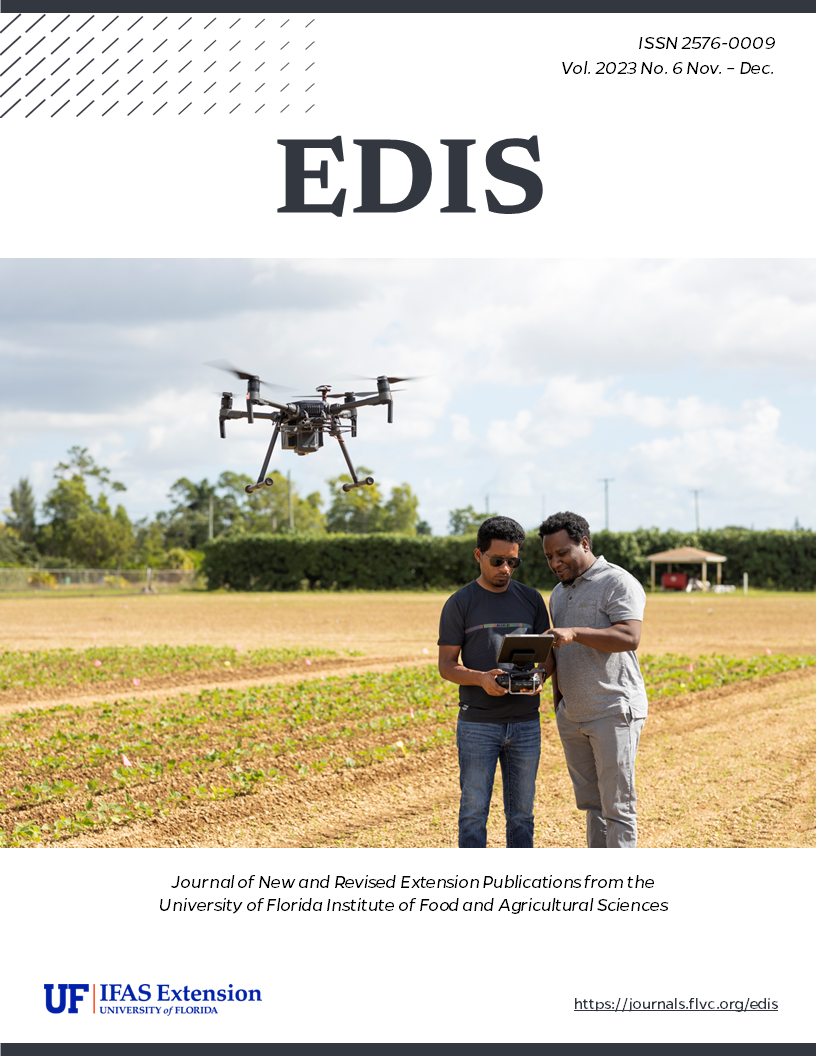Abstract
This publication describes the biology, distribution, behavior, and impact of the parasitoid Leptomastix dactylopii Howard. This beneficial insect is known for providing significant reductions in mealybug populations in Florida and other locations. It is also intended to provide knowledge about this parasitoid to a wide range of interested audiences including growers, Extension agents, researchers, students, laypersons, and other stakeholders.
References
Anga JM, Noyes JS. 1999. “A revision of the African and Malagasy species of the genus Leptomastix (Hymenoptera, Encyrtidae), parasitoids of mealybugs (Homoptera: Pseudococcidae).” Bulletin of The Natural History Museum (Entomology Series) 68: 93-128.
Battaglia D, Tranfaglia A, Franco JC, Carvalho CJ. 1996. “Leptomastix dactylopii Howard (Hymenoptera, Encyrtidae) fecundity and innate capacity for increase under laboratory controlled conditions.” Bollettino del Laboratorio di Entomologia Agraria 'Filippo Silvestri', Portici 18: 1-150.
Bartlett BR.1978. “Pseudococcidae.” In: Clausen CP (ed.), “Introduced parasites and predators of arthropod pests and weeds: A world review.” Agriculture handbook no. 480 (pp. 137–170). USDA Washington, DC.
Blumberg D, Van Driesche R.G. 2001. “Encapsulation rates of three encyrtid parasitoids by three mealybug species (Homoptera: Pseudococcidae) found commonly as pests in commercial greenhouses.” Biological Control 22: 191–199. https://doi.org/10.1006/bcon.2001.0966
Chong JH, Oetting RD. 2007. “Specificity of Anagyrus sp. nov. nr. sinope and Leptomastix dactylopii for six mealybug species.” BioControl 52: 289–308. https://doi.org/10.1007/s10526-006-9025-5
Cocco A, da Silva VCP, Benelli G, Botton M, Lucchi A, Lentini A. 2021. “Sustainable management of the vine mealybug in organic vineyards.” Journal of Pest Science 94: 153-185. https://doi.org/10.1007/s10340-020-01305-8
Daane KM, Cooper ML, Triapitsyn SV, Walton VM, Yokota GY, Haviland DR, Bentley WJ, Godfrey KE, Wunderlich LR. 2008. “Vineyard managers and researchers seek sustainable solutions for mealybugs, a changing pest complex.” California Agriculture 62 (4): 167-176. https://doi.org/10.3733/ca.v062n04p167
Daane KM, Almeida RPP, Bell VA, Walker JTS, Botton M, Fallahzadeh M, Mani M, Miano JL, Sforza R, Walton VM, Zaviezo T. 2012. “Biology and management of mealybugs in vineyards.” In: Bostanian NJ, Charles V, Isaacs R. (eds.), “Arthropod Management in Vineyards: Pests, Approaches, and Future Directions.” Springer, New York, pp. 271-307. https://doi.org/10.1007/978-94-007-4032-7_12
de Jong P, and van Alphen JJM. 1989. “Host size selection and sex allocation in Leptoma.stix dactylopii, a parasitoid of Planococcus citri.” Entomologia Experimentalis et Applicata 50: 161-169. https://doi.org/10.1111/j.1570-7458.1989.tb02385.x
Diepenbrock LM, Stelinski L, Martini X, Qureshi J. 2022. “2022–2023 Florida Citrus Production Guide: Soft-Bodied Insects Attacking Foliage and Fruit: CPG Ch. 26, CG004/ENY-604, Rev. 3/2022”. EDIS 2022 (CPG). https://doi.org/10.32473/edis-cg004-2022
Doutt RL. 1952. “Biological control of Planococcus citri on commercial greenhouse Stephanotis.” Journal of Economic Entomology 45(2): 343-344. https://doi.org/10.1093/jee/45.2.343
Franco JC, Suma P, da Silva EB, Blumberg D, Mendel Z. 2004. “Management strategies of mealybug pests of citrus in Mediterranean countries.” Phytoparasitica 32: 507-522. https://doi.org/10.1007/BF02980445
Krambias A, Kontzonis A. 1980. “Establishment of Leptomastix dactylopii How. in Cyprus.” Fruits 35: 783-785.
Krishnamoorthy A, Singh SP. 1987. “Biological Control of Citrus Mealybug, Planococcus citri with an introduced parasite, Leptomastix dactylopii in India.” Entomophaga 32: 143-148. https://doi.org/10.1007/BF02373124
Lloyd DC. 1958. “Studies of Parasite Oviposition Behaviour.: II. Leptomastix dactylopii Howard (Hymenoptera, Encyrtidae).” The Canadian Entomologist (8):450-61. https://doi.org/10.4039/Ent90450-8
Mahfoudhi N, Dhouibi MH. 2009. “Survey of mealybugs (Hemiptera: Pseudococcidae) and their natural enemies in Tunisian vineyards.” African Entomology 17: 154-160. https://doi.org/10.4001/003.017.0205
Mani M. 1994. “Effectiveness of the exotic encyrtid parasitoid, Leptomastix dactylopii How. in the control of mealybug, Planococcus citri (Risso) in guava orchards.” Journal of Entomological Research 18: 351-355.
Marras PM, Cocco A, Muscas E, Lentini A. 2016. “Laboratory evaluation of the suitability of vine mealybug, Planococcus ficus, as a host for Leptomastix dactylopii.” Biological Control 95: 57–65. https://doi.org/10.1016/j.biocontrol.2016.01.007
Muştu M, Derya FN, Tarhanacı B. 2022. “Host stage preference and demographic parameters of Leptomastix dactylopii (Hymenoptera: Encyrtidae) on vine mealybug Planococcus ficus (Hemiptera: Pseudococcidae).” Egyptian Journal of Biological Pest Control 32:75. https://doi.org/10.1186/s41938-022-00572-0
Noyes JS, Hayat M. 1994. “Oriental Mealybug Parasitoids of the Anagyrini (Hymenoptera: Encyrtidae).” CAB International, Wallingford, Oxon, UK.
Smith D, Papacek DF, Murray DAH. 1988. “The use of Leptomastix dactylopii Howard (Hymenoptera: Encyrtidae) to control Planococcus citri (Risso) (Hemiptera: Pseudococcidae) in Queensland citrus orchards.” Queensland Journal of Agricultural and Animal Sciences 45: 157-164.
Su T, Li C. 1993. “Factors affecting the sex ratio of Leptomastix dactylopii Howard, a parasitoid of Planococcus citri (Risso).” Chinese Journal of Entomology 13(4): 319-329.
Tingle CC, Copland MJ. 1989. “Progeny production and adult longevity of the mealybug parasitoids Anagyrus pseudococci, Leptomastix dactylopii, and Leptomastidea abnormis [Hym.: Encyrtidae] in relation to temperature.” Entomophaga 34:111-20. https://doi.org/10.1007/BF02372594
Van Baaren J, Nénon JP. 1994. “Factors involved in host discrimination by Epidinocarsis lopezi and Leptomastix dactylopii (Hymenoptera: Encyrtidae).” Journal of Applied Entomology 118: 76–83. https://doi.org/10.1111/j.1439-0418.1994.tb00781.x
Walton VM, Pringle KL. 2004. “A survey of mealybugs and associated natural enemies in vineyards in the Western Cape Province, South Africa.” South African Journal of Enology and Viticulture 25: 23-25. https://doi.org/10.21548/25-1-2134
Yang J, Sadof CS. 1997. “Variation in the life history of the citrus mealybug parasitoid Leptomastix dactylopii (Hymenoptera: Encyrtidae) on three varieties of Coleus blumei.” Environmental Entomology 26: 978-982. https://doi.org/10.1093/ee/26.4.978.
Zinna G. 1959. “Ricerche sugli insetti entomofagi I. Specializzazione entomoparassitica negli Encyrtidae. Studio morfologico, etologico e fisiologico del Leptomastix dactylopii Howard.” Bollettino del Laboratorio di Entomologia Agraria 'Filippo Silvestri', Portici 18:1–148.
Zinna G. 1960. Esperimenti di lotta biologica controil cotonello degli agrumi (Pseudococcus citri (Risso)) nell'Isola di Procida mediante l'impiego di due parassiti esotica, Pauridia peregrina Timb. e Leptomastix dactylopii How. Bollettino del Laboratorio di Entomologia Agraria 'Filippo Silvestri', Portici 28: 257-284.

This work is licensed under a Creative Commons Attribution-NonCommercial-NoDerivatives 4.0 International License.
Copyright (c) 2024 UF/IFAS

